In our experience at Clevens Face and Body Specialists, patients are most satisfied with their facial plastic surgery experience if they consider the following key question throughout their voyage: “When we meet one year after your procedure has been performed, what has to have happened during that year for you to be happy with both the process and your result?”
Your Plastic Surgery Companion


A Helpful Resource Authored by Dr. Clevens
At first glance, the ‘answer’ to this question appears self-evident. But as you ponder this question, give it some serious consideration before responding. Based upon our research into patient satisfaction with cosmetic surgery, we have developed a seven step unique process that guides our patients to success through the facial plastic surgery odyssey.
Below is the first chapter of Dr. Clevens' book.

Download a PDF version of this guide by filling out this form, or keep scrolling to read.
Chapter 1.1
Knowledge is Power
Did you know the term ‘plastic surgery’ comes from the ancient Greeks and refers to ‘the art of modeling.’ The artificial material that we know today as ‘plastic’ is not used in plastic surgery. Instead, the ‘plastic’ we refer to in plastic surgery is derived from the Greek plastikos, which means that something is supple, changeable or moldable. While Cosmetic Surgery is a relatively new field, the art and science of plastic surgery is centuries old. Records show that the first plastic surgery was performed in India nearly 2,500 years ago and the ancient Romans regularly partook in rudimentary beautification procedures several hundred years later.
When you embark on major life changes, it is important to get as much information as you can. This is especially true when you are looking to enhance your facial appearance. The first stage of this adventure consists of seeking factual information in order to learn everything that you can. This is really the most important part of the process towards cosmetic surgery. At our Center of Excellence, known as Clevens Face and Body Specialists, this stage is known as “The Knowledge Builder.”
The Knowledge Builder
Before you even walk through the doors of a cosmetic surgery center, you have likely spent time researching procedures, looking at prospective surgeons and considering the world of possibilities.
Since you scheduled a consultation with the surgeon of your choosing means that you have sorted through all of the potential medical teams out there and decided that working with a facial plastic surgery specialist best fits your needs. Professional medical personnel understand how important this decision is to you, and you can be certain, the goal of your surgeon is to ensure that this decision becomes the best decision that you have ever made.
The Knowledge Builder process starts long before you ever schedule a consultation with a plastic surgeon, but it doesn’t end with your consultation appointment either. You are encouraged to learn everything that you can about your potential procedure; as The Knowledge Builder is more than learning about the surgical process.
The Knowledge Builder also involves getting to know your surgical team and starting the process of developing key relationships. You will get to know the professionals that will attend you, and they will get to know you as well. The best patient is the most knowledgeable patient. Experienced professionals will welcome your curiosity and will encourage you to expand your knowledge base. This is a crucial part of your overall experience.
As a result, you can feel certain that from the moment you first step into a plastic surgery clinic for the first time, you have entered a center of excellence with the most highly competent and experienced medical staff. Fully qualified and caring staff members are prepared to receive you. They are there to help you with your unique and individual concerns.
You have genuine concerns about the way you look, and these concerns affect how you feel about yourself. Since you have already done the research and have put a lot of thought into your situation, sharing this information with the right people is critical to your
success.
Only by understanding what you want and need can the professionals start to build a level of communication that will serve you throughout the rest of your process.
And perhaps most importantly, good staff members understand that you need to develop a sense of trust before you are comfortable talking about your worries and fears.
During this part of the process, experts work hard to develop a connection with you and to create a strong relationship so they may gain the privilege of your trust. These experts who range from consultants to surgeons want you to feel comfortable and as relaxed as possible. Your honesty and openness is important to help us get the results you desire.
Your key to gaining knowledge from your surgeon and his staff emerges from your candid communication with your team. It is important that you relate just how you feel about your present image. You need to be comfortable in sharing what is on your mind because this is how your team ensures your needs are met and your expectations are exceeded. Try asking yourself an important question. If you and your medical team were sitting down one year from today, what would you have hoped to accomplish together in order for you to be absolutely thrilled with your results?
Robert Frost, one of America’s most revered poet laureates, once said, “Half the world is composed of people who have something to say and can’t and the other half who have nothing to say and keep on saying it.” It is our most sincere hope that you have a lot to say, and that you can and will say it. You deserve to be heard and a promise to listen should form the foundation of the patient-doctor relationship.

Chapter 1.2
The Aging Process
The reality is that we are all going to age, and no matter how great our genes, eventually the signs of the unavoidable aging process are going to show on our bodies. The face is the first area that people look at when they see you. Aging in the face is going to say a lot more about your life than you might realize.
Whether we like it or not, people make assumptions, first impressions, and snap judgments about who you are and what we believe based on how you look. Research has shown that youthful, good-looking people are treated better, earn higher salaries and enjoy life more completely. Attractive people earn over $140,000 more than their ‘average’ looking peers over the course of a lifetime and at least 3-4% more annually. Attractive people are considered more influential and find more occupations available to them. This may seem unfair or superficial, but the unfortunate fact is that this is indeed true. It is important that your appearance truly matches how you feel and conveys the message that you want to send to the world. Looking and feeling better translates into greater personal and financial success.
Your face is an amazing creation. It is comprised of an incredible paired set of 44 precise muscles. These muscles are unlike any other muscles in the body. Whereas other muscles connect from bone to bone to move joints and limbs, facial muscles are unattached to bone and insert into the overlying skin. Their sole function is to create facial expressions that convey to your fellow man how you are feeling. Facial expression is a uniquely human characteristic that has evolved to allow nonverbal communication of emotion and intimacy.
It is remarkable that the human face can make over 7,000 different facial expressions. Imagine the complexity of emotion and feeling conveyed by this amazing anatomical array. And each face is completely unique. Look around you ... no two faces are alike! You should honor your face and recognize what a masterpiece it really is.
No matter how much you love the way you look, the aging process is inevitable for each and every one of us. As each decade passes, there will be certain changes that affect your face, neck, and skin. What basic changes should you expect to see as you age and what cosmetic procedures might be able to help you curb the signs of aging?
Let’s explore your options in the following paragraphs.
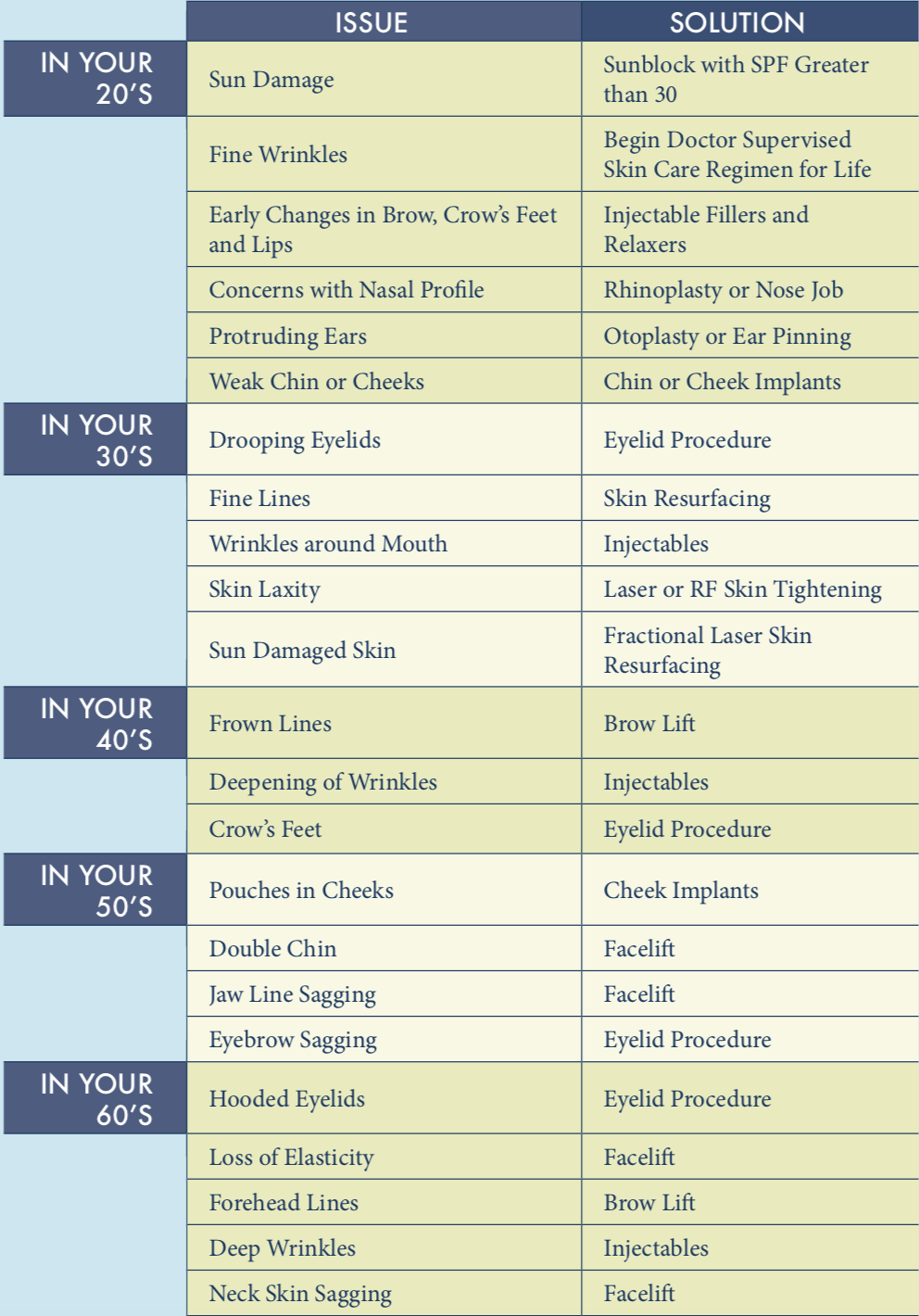

Chapter 1.3
Exploratory & Checklist Questions
Coming in for your consultation involves learning more about your potential surgical procedure as well as begins the process of building rapport. Naturally, you will likely have plenty of questions about process, procedure, and the like, that we will discuss later.
Before we explore these details, we want to talk about the specific reasons behind your plan for cosmetic surgery. and consider the following questions:
- What is it that bothers you about your appearance?
- How is this concern affecting your life?
- How do you think surgery will address the problem?
- Will surgery change your feelings about yourself?
- How do you think your new image will make your life better?
- How long of a recovery time do you have available?
- Are you seeking a surgical or nonsurgical solution? What is your budget?
- What anxieties or fears do you have?
- What needs to happen in order for you to be happy with your outcome and during your journey?
Questions like these are extremely important. Sharing your thoughts about these questions with your facial plastic surgeon will help your team better understand what you might be expecting surgery to do for you. The answers to these questions will also help to determine the best course of action. And,most importantly,the answers to these questions might just give you a better idea of what you really want.
At this point in your journey, we at Clevens Face and Body Specialists encourage our patients to start a journal. Consider this journal your official cosmetic procedure diary. It is the one place where you can keep track of your thoughts and feelings about your procedure as well as the process. By writing in a journal you can start to find clarity around your situation. It is a place where you can intimately express your issues, worries, fears, and excitement. This can help you confidentially express your questions and concerns to your surgeon and your team, and communicate exactly what you want and what you are feeling.
if you read the above questions and don’t yet have clear answers, or any answers at all, we encourage you to write these questions down in your surgical journal. In fact, even if you do have clear answers we recommend that you write these questions down and give some time and thought to the answers. Make this the first thing you do with your journal. Even if your answers seem obvious right now, write them out anyway. You might be surprised by what comes up.
If you read the above questions and don’t yet have clear answers, or any answers at all, we encourage you to write these questions down in your surgical journal. In fact, even if you do have clear answers we recommend that you write these questions down and give some time and thought to the answers. Make this the first thing you do with your journal. Even if your answers seem obvious right now, write them out anyway. You might be surprised by what comes up.
You may also want to start a photographic journal that can also be used for pasting photos, images, and other items that relate to how you might want to change your appearance. This album might include photos of yourself, perhaps photos that expose what concerns you. Many patients find that collecting images from when they were younger helps them to collect and organize their thoughts about what they want to correct. Some patients will also clip pictures of celebrities and athletes who have characteristics that they are hoping to emulate. In considering rhinoplasty (nasal contouring surgery), as an example, it is very common for folks to cut out pictures of noses they like and do not like in order to communicate their wishes more clearly to their surgeon.
Like all diaries, your facial plastic surgery journal may be a private place where your thoughts, fears and desires can be stored. By keeping all of your information in one place you can more easily show us what you want and express how you are feeling. the next thing you should do in your journal is to create a list of questions for your surgeon and team to answer. We refer to this as a ‘checklist of questions.’ This will help you to remember all of the issues that you want to have addressed when we meet. By having everything in one place it will be easier for you to share what is important and to have all of your questions answered.
The goal of facial cosmetic surgery is to create a happy and satisfied patient at the end of the journey. The definition of satisfaction varies from one patient to the next and not all patients would answer a set of questions in the same way. This is the individuality of each person’s unique set of concerns, which we try to uncover as part of the ‘The Knowledge Builder’ phase of your odyssey.
A Checklist of Questions
Anytime you are getting a procedure done, seek a well trained and board certified surgeon in the proper area of expertise. Doctors certified by the American Board of Facial Plastic and Reconstructive Surgery have completed rigorous training lasting from five to seven years beyond college and medical school specializing in facial, head and neck surgery and have passed a comprehensive certifying exam. Such surgeons are uniquely qualified to perform facial cosmetic and reconstructive surgery.
Surgeons certified by the American Board of Plastic Surgery have also completed extensive training in plastic surgery. Plastic surgeons commonly focus on all aspects of plastic and reconstructive surgery, not only facial surgery but also surgery of the breast, body and extremities.
You will likely have a set of your own questions that you will want answered, but here is a checklist that we recommend patients consider to ensure they have the answers before moving forward with any surgeon:
- Is what you want exactly what you need?
- Does my surgeon specialize in the sort of procedure I am considering?
- How often does my surgeon perform the procedure that interests me?
- Is surgery the answer or are there alternatives?
- If surgery is the answer, then what will my image be afterwards?
- Do you have that computer imaging technique that I’ve seen advertised so much in the
- newspaper and on television?
Also keep in mind the specific questions connected to the procedure, before, during, and after:
- Where will the actual surgery take place: in a hospital, in the clinic?
- What kind of preparation will I have to make at home and at work before the surgery?
- How long will the surgery itself take?
- Will I have to undergo anesthesia, and if so, what kind?
- Will I be in pain?
- What kinds of medication will I have to take before and after?
- Will I have any side effects and what are the risks of complications?
- Will I need some kind of at-home care?
- When will I be able to go back to my normal activities?
- When can I go back to work?
- The next questions to consider are related to money and payment:
If surgery is the answer, then how much will it cost?
- Will I have to pay for this in one lump sum or can I pay over a period of time?
- Will my insurance cover this? How can I find out?
- What is included in the fee and what is not included?
- Are anesthesia and facility fees included or extra?
- Will I need a nurse after surgery to help take care of me and how much does this cost?
All of these are serious and legitimate questions that rightfully concern every patient. Because insurance does not include most facial cosmetic surgery procedures, you will need to pay out of pocket in all likelihood. Do not be bashful about asking questions related to cost and what is and is not included in your cost estimate. You deserve clarity up front as to your financial investment. Listed above are some of the more common questions that your surgeon and his staff should address during your consultation. But there will be many more. Just remember to write all of your questions down in your journal and bring them up during your consultations.
You need to be informed and educated throughout your process. Our philosophy at Clevens Face and Body Specialists is that the best patient is the well-educated patient. We truly believe that the more prepared you are for your first meeting with our team of professionals, the less anxiety you will have as you start to move forward towards your procedure. This philosophy is what The Knowledge Builder is all about. You need to feel comfortable and at ease with the surgeon and his attending staff. When you have comfort and ease, you will feel more self-assured and confident that what you are doing is the absolute right thing to do. Knowledge is power.
As we move forward in this chapter you will see questions in bold. These are questions that you should answer before your consultation appointment. This is another place where you should write these questions down and take your time in answering them. Bring your answers with you to your consultation. This will help the process go smoother and ensure that you have given your undivided attention to the questions. Many patients feel that their concerns are not fully addressed in a single visit to the doctor. Questions arise after their visit. We have found that many patients return in person for a second consultation to clarify their concerns. Other patients email or call to be certain that all of their questions are answered.
As part of the Knowledge Builder process, patients are encouraged to return to make certain that their questions are fully addressed to their complete satisfaction before scheduling their procedure.

Chapter 1.4
Why Are You Doing It?
Why do you want plastic surgery? This might seem like a silly question, of course, because you simply want to change your look. But this is actually one of the most important questions that is asked during your consultation. It is important to assess your intention behind seeking plastic surgery. I often ask my patients, “Why now?”
It is imperative that you are seeking surgery solely for your own reasons and not for someone else’s or with a different ulterior motive. If you are looking to get plastic surgery because someone else in your life wants you to do it, then it is likely that there are underlying problems that the surgery will not be able to solve.
Getting surgery for someone else is never the right answer. If you are seeking a cosmetic procedure to satisfy someone other than yourself, then disappointment is likely and we will encourage you to look at other options rather than a cosmetic procedure.
Plastic surgery is a gift to yourself because you have earned the privilege and because you deserve it.

Chapter 1.5
What Are Your Expectations?
Coming into your consultation with your journal is a great first step. This will help you to have all of your thoughts and ideas in one place. This is very important because one of the first things the staff will want to know is what your expectations are for your facial surgery.
Unfortunately, there is a lot of false and unrealistic information about plastic surgery. Inconsistent information can be found on the internet, in different forms of media and even in some printed literature. For the first time, prospective facial plastic surgery patients are facing a barrage of infomercials from national plastic surgery chains that have unfortunately brought fast food quality to the art of plastic surgery. Too often patients come to their consultations with a fantasy of what their lives will be like after their procedure is completed. These fantasies have been influenced by unreliable, and often wrong, information. If it sounds too good to be true, then it probably is.
Too often, people believe that cosmetic surgery will cure their depression, help them find true love, make them famous, or make them rich. The reality is that none of these things is true. And if any of these claims are part of your expectations, then you are seeking plastic surgery for the wrong reasons. You should consider facial plastic surgery for yourself -- to help you feel better about yourself and to make you look as good as you feel. Facial plastic surgery should be for you, so you feel better about yourself and for no one else. Because there is so much incorrect information available, we believe it is important to create a realistic picture of what you can expect from your procedure. The best way to avoid disappointment in your surgical outcome is to have a clear and realistic idea of what plastic surgery can do for you. Again, knowledge is power. When you share what you want, experienced professionals are able to give you a clear picture of what is possible and what they can do to help you get there. If you do discover some misconceptions during the consultation, the goal of the medical team should be to educate you on what can be expected from your surgical procedure and give you a more accurate vision of reality.
Your facial plastic surgeon and his staff should be straightforward in informing you, both in conversation and in written form, precisely what plastic surgery can and cannot do. Knowledge is power and with a little help you will grow confident in making an educated decision on what is best for your future.
The American Academy of Facial Plastic and Reconstructive Surgery has a very reliable and accurate website. This site also features brief descriptions and videos of the main procedures in facial plastic surgery. The Clevens Face and Body Specialists site is another reliable source of information for prospective patients.

Chapter 1.6
What Are Your Possible Options?
After discussing your reasons and hopes for your cosmetic procedure, we will then review the possible outcomes and the options that are available to you. When you have a clear picture of what the end results might be, you will have a better idea as to whether plastic surgery is truly what you want at this time.
As briefly discussed before, there are many misconceptions as to what plastic surgery can do. It is important that you understand that you will not just wake up after surgery, look in the mirror, and instantaneously see your face magically transformed. There is a period of healing and recovery before your final outcome will be seen and ‘the new you’ is apparent. This aspect of facial plastic surgery is discussed in greater detail later in the book and in your personal consultation.
It is also important that you are psychologically prepared for the results of your procedure. Counting on the successful outcome of your facial surgery, you will want to give some thought as to how you will respond to yourself, your friends, and your family. Looking into the mirror and seeing a different reflection looking back at you can be a challenging experience. This is often a reflection of a younger looking you ... perhaps as you looked 10-15 years ago. Or, it might be a version of you without some troubling attribute such as a crooked nose, a hump on your nose or protruding ears. Regardless of your concerns, there will be a new you in the mirror.
You might think that seeing an improved version of your face won’t be a big deal, but many people take a while to grow accustomed to their new appearance. Even when subtle changes are made they may seem like major changes to you. No one knows your face like you do, and even the tiniest adjustment can appear totally transformative when you look in the mirror. Your new reflection may not appear exactly as you anticipated, but it should be a refreshing improvement that may take some time to get used to. Rest assured though, you will look better, not different.
Family members might not be as supportive to the process as you would like them to be. Often patients try and hide their procedure from their spouse, but we strongly encourage involving your family in this important decision. Having support from your loved ones is critical. Being honest with them is going to help you feel more secure and at peace with your decision. Hopefully, you have shared your motivation with your family members and they value your decision. This openness and understanding calms the waters for smooth sailing.
Adult children are often the ones who struggle the most with changes to your appearance. This is because your kids love you as you are and don’t want to see you change. If any of your loved ones are not supportive of you moving forward with a cosmetic procedure, it is important that you stand your ground and explain your reasoning behind the surgery. Again, you should consider facial plastic surgery as a gift to yourself that will help you feel better about yourself or some aspect of your self. Remember why you want to have this procedure done in the first place. I truly believe your inner beauty is linked with your outward appearance. If a few upset family members or friends cause you doubt, then it might not be the time to move forward. You need to be firm in your resolve and positive that this is what you want, even when others don’t agree with you.
Overall you must want to have the surgery because of you and you alone. What others think shouldn’t really matter, but you will still need to deal with the reactions and opinions of the people in your life. Being prepared for these reactions is going to be important to making the final decision about whether or not moving forward with your surgery is right for you.
When thinking about your physical changes after the cosmetic procedure, here are some important questions to ask yourself:
- How will you plan on assimilating back into your circle of friends with your new look?
- Will they like the results, will they not, will they be indifferent?
- Will you be prepared to handle the responses, come what may?
- What if your friends are not supportive of the new you?
- Do you have the confidence to appreciate the change?
- What if your reflection is improved, but its not quite exactly what you had hoped for?
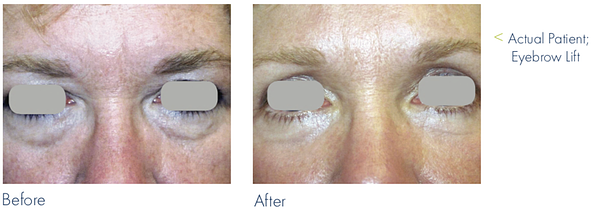
After seeing some images of possible outcomes from your cosmetic procedure, it is important to ask yourself these two questions:
- Are the end results that we discuss what you really want?
- Are the end results what you really expect or do you have further doubts?
If you have doubts, or if the outcome isn’t what you expected, this is important information for you and for your surgeon and his team to know. You can discuss other alternatives to surgery that might be more conducive to achieving your desired result. There are other ways to solve certain facial aesthetic concerns. If you are apprehensive about whether or not you are ready for a surgical procedure, you can look at some of the nonsurgical solutions with your surgical team. The bottom line is if you are not totally ready and 100 percent sure, then the surgery should not happen.
Minimal or non-invasive procedures are becoming more common. Certain creams and sunblocks, moisturizers, lasers, Botox and other injectables are among the less invasive options that might be a better fit for you. If you still want to make changes to your appearance but have doubts about the surgical process, we will happily explore these other options with you. At the current pace of innovation, these alternative options increase in number practically every day.

Chapter 1.7
Let's Go to The Computer
Modern technology has given us the ability, through computer programs, to create an image of what you might look like after your cosmetic procedure. The results we are able to get from these computer programs are remarkably accurate. Facial Cosmetic Surgery Imaging is truly a modern miracle. The technology allows you to view yourself before and after the cosmetic surgery is completed.
Let’s say, for example, that you are considering having your eyes done. The images on the computer screen can show you just what you will look like after surgery addresses your dark circles, excess skin, or the bags underneath your eyes. With a few simple clicks of the computer program, the imagery will immediately display what the art of plastic surgery can do to sculpt younger looking eyes. The same process can be applied to all other aspects of the face: for example, shape a new nose, contour the chin, rejuvenate the neck, or even erase unsightly wrinkles caused by the passage of time, smoking or excess sun exposure.
Facial Cosmetic Surgery Imaging can educate you on what will be done and exactly how the surgery will be performed to create the best desired results for your unique image. This program can give you a visualization of your predicted results. Armed with this visual depiction of your results, you will have details of the best path towards obtaining the results that you want.
Facial Cosmetic Surgery Imaging is an important educational tool. Although actual results may vary owing to the complexity and uniqueness of the human body, imaging creates a forum where the surgeon can interact with you and discuss the possible variations of the results. For example, the surgeon may image a patient seeking rhinoplasty (nasal contouring) who is also wondering whether or not to consider a chin implant. The surgeon can create two ‘after’ images, one with rhinoplasty and chin implant and one with rhinoplasty alone. This enables the patient to visualize the results of both versions. As we’ve remarked already in this book, the goal of cosmetic surgery is to create a happy patient -- one who is pleased with his or her surgical outcome. Facial Cosmetic Surgery Imaging enhances patient satisfaction because it helps your outcome on the computer match the vision that you have in your mind’s eye.
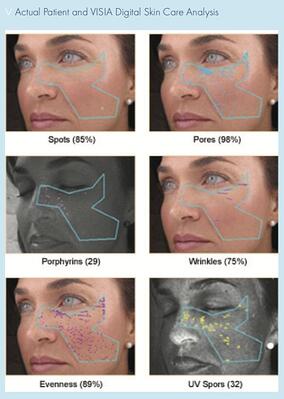
VISIA analysis uses unique digital imaging techniques that unveil the underlying condition of your skin. VISIA reveals the degree of sun damage, pigment changes, spider vein formation and skin texture and quality. Many cosmetic facial surgery centers use VISIA technology to help select the methods of skin care, nonsurgical solutions, and surgical procedures that are best suited to the needs of your skin. Imperfections of the skin such as lines, brown spots and sun damage occur at different levels of the skin. Some changes occur deeper in the skin at the level of the dermis, while others affect only the surface of the skin or the epidermis.
Technologies such as VISIA analysis help to determine at which level within the skin the changes have occurred. With the knowledge gained from VISIA imaging, the appropriate treatment method can be fine tuned to target the site of damage.

Chapter 1.9
Skin Type and Surgery
Your skin type, ethnicity, skin color, and the texture of your skin will all have a bearing on how you will age and the major issues that you might be facing as time goes on. Here is a basic breakdown of the different skin types, how they age, and their significance in cosmetic procedures. Of course, it is important to keep in mind that you are an individual and each person is going to be different. This is just a starting point.
ANGLO-SAXON {Fair Complected with Red Hair}
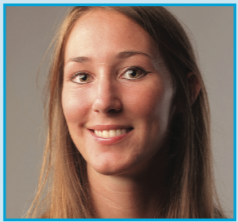
Individuals with this background tend to have red hair, blue or green eyes, freckled skin that is sensitive. With sun exposure, their skin burns and never tans. Skin cancer and sun damage are common with marked sun sensitivity. People who are fair- skinned have several benefits that will help them with cosmetic procedures. The skin drapes easily, which allows more precise changes to be made. Scars are usually small, heal easily, and are mostly unnoticeable. Swelling with this type of skin is minimal, but bruising may be more obvious. The challenges with this skin type are that the signs of aging will appear earlier than with any other skin type. They are more prone to sun damage. Fine wrinkles may be more difficult to remove and any irregularities in the face or on the skin are much more obvious against the fine white complexion.
NORTHERN EUROPEAN {Fair Complected With Blonde Hair}

People who are fair-skinned with blond hair are very similar to the Anglo-Saxon type of skin. They tend to have blue or green eyes and sensitive skin that burns rather than tans with sun exposure. Skin cancer and sun damage are also common with marked sun sensitivity. The skin tends to be thin, which means that it is easy to manipulate. Incisions disappear easily and blend within the skin. Swelling with this type of skin is minimal, but bruising may occur. The signs of aging are going to be obvious early and deep wrinkles may form die to sun sensitivity.
AFRICAN {Dark Complected With Dark Hair and Eyes }

This skin type shows the signs of aging at the latest point.
The skin is resistant to sun damage and skin cancer is rare. Fine wrinkles typically never form. Swelling from surgical procedures may last a while but bruising is less common. Scarring may become thickened with this type of dark complexion. Certain sites tend to form thickened scars, but again, facial incisions tend to heal much better than non-facial sites. There is also a greater risk of pigmentation issues and the cartilage isn’t easily manipulated. Attentive care during and after surgery improves healing of the incisions.
CENTRAL EUROPEAN {Olive Complected With Dark Hair}
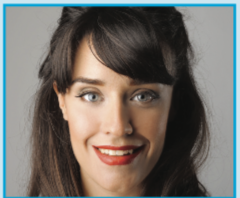
Individuals of this ethnogeographic background tend to have thicker and more oily skin. The skin is less sensitive to the sun. It tends to tan rather than burn. Hair and eyes are commonly dark. Sun damage and skin cancer is less common. This skin type is more protected from the sun and signs of aging appear a little bit later in life. Incisions are often thin and easy to hide. The structure of bones and cartilage is stronger and often easy to work with. People with this skin type often run into pigmentation. There can be unwanted blotchiness of the skin with areas of lightening and darkening. Pale incisions may be more obvious than with some of the lighter skin tones.
SOUTH EUROPEAN HISPANIC, ASIAN PACIFIC
{Ethnogeographic Skin and Hair Pigmentation}
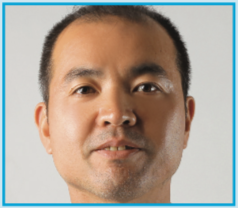
The signs of aging will appear much later with this skin type. Fine lines and wrinkling are less with this type of skin owing the protection from the sun gained by its pigmentation. On the other hand the skin tends to be thicker, which means that it is more resistant to lifting during surgical processes. Swelling tends to last longer with this skin type and scarring may be thick- er, darker, and more obvious. There are certain precautions we must take at the time of surgery and in the after-care to ensure optimal healing. It is fortunate that facial incisions tend to heal much better than non-facial sites.
SOUTH ASIAN, INDIAN
{Dark Complected With Thicker, More Oily Skin}

The signs of aging come on much later than with most of the other lighter skin types. Cancer of the skin is very rare with this skin type. The cartilage with this skin type is resistant to surgical manipulation and tends to droop with aging. Thickened scars may occur and swelling after surgical procedures can last longer than in fine skinned individuals. At the time of surgery we exercise great care in the placement and closure of incisions to improve the outcome. There are special care techniques after surgery that can improve healing. Again, it is fortunate that facial incisions tend to heal much better than non-facial sites and keloid scarring is rare on the face.

Chapter 1.10
The Science of Beauty
Did you know there is a scientific equation that reveals what people consider beautiful? It has been proven that an even and symmetrical face is considered to be more beautiful. The more symmetrical a person’s face, the more appealing that person is to the opposite sex. Recalling notions put forth by the ancient Greeks, research confirms that balanced facial features are considered more beautiful by observers. Symmetry is perhaps the most important ingredient in human impression of beauty. The good news is that symmetry can often be created with surgical means.
There is a certain amount of physical beauty that can be measured. There is a mathematical equation that can be used to measure the symmetry and determine how attractive your face actually is. Using this system, if one or two things are adjusted in an unattractive face, it suddenly becomes attractive. Very little change is needed to totally transform how someone is viewed. These are subtle changes indeed.
- Short upper lip
- High cheekbones
- Small nose
- Short distance between the chin and mouth
- Large eyes, widely spaced apart
- Fine jawline
- Petite chin
- Heavy brows
- Full head of hair
- Prominent chin
- Strong jawline
- Rectangular face shape
- Deep set eyes
Of course, very few individuals on the planet have a perfectly symmetrical face ... at least without some help. Naturally, there always will be some asymmetries between the left and right sides of our faces; this is what makes each of us appear unique
as individuals. During your consultation, your facial plastic surgeon should examine the symmetry of your face and see what can be done to bring more evenness to your look.
It is believed that much of your psychological well-being is connected to your sense of self-esteem. The creator of modern plastic surgery, Jacques Joseph, said that self-esteem is enhanced when the facial features are in harmony. So much of beauty and attractiveness is based upon the balance and interplay of facial features. A weak chin or a high, sloping brow makes our nose look prominent. A down-turned corner of the mouth creates the impression of anger or bitterness. We look tired if our lids and brows are droopy. Society places such a large emphasis on the way we look. The way that we look sends messages to other people about who we are. The way we look gives people clues to how we feel and even what our aspirations are. In certain cases, plastic surgery helps our outside appearance mirror our inside feelings.
It used to be that only the wealthy, famous, and elite could get plastic surgery, but this is no longer the case. Advancements in the field and growing interest in cosmetic procedures have made it possible for people of any background to be able to get cosmetic procedures.
Whether we want to believe it or not, people who are considered attractive by these standards tend to have an easier way getting through the world. People are more likely to help out someone they consider beautiful rather than someone they consider plain. This has been proven in studies time and time again. Psychologists say that beautiful people get better jobs, earn more money, get better service, and even have better sex lives.
“Beautiful People” does not have to be a term that is referring to someone else. Anyone can be one of the “Beautiful People.” All it takes is a little commitment from you to make the change.

Chapter 1.11
How Will You Prepare for Your First Visit with Your Facial Plastic Surgeon?
By the time you schedule your individual consultation with your facial plastic surgeon, you will have already taken the very important first step towards your successful facial surgery - talking to the clinic staff.
Your next step will be to talk to the surgeon personally, allowing him or her to establish exactly what can be done for you and to clarify your vision of how you want to look. Tools such as your journal, computerized video imaging and VISIA imaging will help you get the most out of your consultation.
In order for your consultation to be successful there are some things that you need to do in preparation for your visit with the facial surgeon.
It takes a lot to walk in the front door of a facial plastic surgeon’s office. The decision to seek facial plastic surgery is about having courage to stand up and do what is best for you. Getting surgery is a big step that will change your life. When you feel better about yourself you will start living a fuller life.
A staff member’s desire is to make you feel as comfortable as possible, but your first meeting with a surgeon might make you nervous. The whole process can be quite stressful, confusing, and even frustrating.
Many patients get so nervous during their initial meeting that they forget everything they want to say and all the questions they want to ask. We have found among our patients that this is a remarkably common experience.
Having your surgical journal (or even this book, see the notes sections at the end of each chapter and on page 224) with you is the best way to prepare for this meeting. Answering all of the questions that we have already outlined and having these questions in your journal is important.
Having your checklist of the questions that you want to have answered is going to make your consultation smooth, easy, and productive.
And lastly, having a clear idea of what you want out of the cosmetic procedure will help you and your surgeon see where you are headed and determine how to get there.
Being prepared before you go for the consultation will help diminish any anxieties that you might be feeling because you will know that you are getting all of the information you need.


Chapter 1.12
Myths and Legends of Plastic Surgery
As we have said before, there is a lot of false information available about plastic surgery: what it is, what it can do, and how it can change your appearance. Continuing with the idea that knowledge is power, here are some of the plastic surgery myths and the truth and the reality behind them.
MYTH: YOU CAN TELL WHEN SOMEONE HAS HAD “WORK DONE.”
REALITY: No doubt you can flip through a magazine or watch a Hollywood event and try to guess who has had work done. We have even heard of people making a game out of it. The truth is that many more people have had cosmetic procedures than you can tell have had them. It is the ‘bad’ or ‘overdone’ plastic surgery that is obvious. Most people don’t want to make it look obvious that they have had plastic surgery, which is our goal. We want to help you look better, not different. Modern and sophisticated plastic surgery looks quite natural, like turning back the hands of a clock with a magic wand.
MYTH: YOU CAN ONLY GET ONE PROCEDURE AT A TIME.
REALITY: Many patients undergo several treatments at the same time. This is not only easier for you as far as recovery time, but it is also less expensive. When you get a brow lift and an eyelid procedure at the same time you only have to cover the costs of the surgical room, anesthesiologist, and medications once. Plus, the recovery time for both of these surgeries is going to be shorter than if you did each of them as a separate procedure broken up over time. Performing complementary procedures at the same time is not only more efficient in terms of cost and time, but also creates more natural and pleasing results. It can look unnatural to rejuvenate one part of your face yet leave an adjacent region unimproved.
MYTH: PLASTIC SURGERY CAN CHANGE ANYTHING WITH YOUR FACE OR BODY THAT YOU DON’T LIKE.
REALITY: This is one of the harsher myths that prevail. Facial plastic surgeons can’t totally transform your look. They still have to work with your underlying facial structure and that can’t always be changed. If you have a specific look that you want to create, surgeons may or may not be able to do that. That is exactly why they go over the realities of cosmetic surgery during consultations. This is so you know what to expect and what is realistic. Previewing video imaging that digitally modifies your appearance to simulate the results of surgery can be helpful in establishing expectations.
MYTH: PLASTIC SURGERY ISN’T ‘REAL’ SURGERY.
REALITY: Plastic surgery is, in fact, real surgery and should not be undertaken lightly. Yes, there are many cosmetic benefits to the process, but there are also risks to having plastic surgery performed. It is important to take into consideration your overall health and well-being for surgery and your preparedness for your procedure. Anytime you are getting a procedure done, seek a well-trained and board certified surgeon in the proper area of expertise. Doctors certified by the American Board of Facial Plastic and Reconstructive surgery have completed rigorous training in facial, head and neck surgery and have passed a comprehensive certifying exam. Such surgeons are uniquely qualified to perform facial cosmetic surgery.
MYTH: PLASTIC SURGERY LEAVES NO SCARS.
REALITY: During a cosmetic surgery procedure, incisions are made. It is impossible to make incisions without some sort of scarring taking place. This is why facial plastic surgeons are required to go through so much training and schooling before they can perform these procedures. Yes, there will be scars, but most often they are hidden or placed where they are not noticeable. The face is blessed with a remarkable capacity for healing, more so than any other part of the body. Facial incisions generally heal very nicely and should not be obvious after your procedure.
MYTH: ONLY WOMEN GET PLASTIC SURGERY.
REALITY: Although the majority of plastic surgery recipients are women, men now seek appearance enhancement in much higher numbers than in the past. Research has shown that men desire aesthetic improvement as much as women do and that cosmetic surgery is considered as acceptable by men as by woman. Currently about 20 percent of all cosmetic procedures are received by men, and every year that number grows. The reality is that our society rewards a more youthful look, and this affects both men and women.
MYTH: ONLY RICH PEOPLE ARE ABLE TO GET COSMETIC PROCEDURES.
REALITY: Once upon a time only the rich and famous were able to get plastic surgery, but those times have changed. Average, everyday people are getting cosmetic procedures. According to the American Society of Plastic Surgeons, two-thirds of people who undergo cosmetic procedures have an annual household income oflessthan$60,000. We are not concerned with your income level; rather we want to work within your budget to help you feel better about yourself and the way you look.
MYTH: ONLY VAIN PEOPLE GET PLASTIC SURGERY.
REALITY: Every person wants to look his or her best: How we look is closely connected to how we feel. People who are vain are totally obsessed with looking good at the exclusion of reality. Vanity means never looking good enough and having the desire to have more of everything. The desire to look your best and to have your outward appearance reflect how you feel inside is a natural aspiration. We find that most of our patients simply come in wanting to make cosmetic changes in order to feel better about themselves. Seeking plastic surgery is not about being vain, but rather about having the courage to stand up and do what is best for you. Getting surgery is a big step that will change your life. When you feel better about yourself you will see that you start living a fuller life.
MYTH: PEOPLE ARE NEVER HAPPY WITH THEIR COSMETIC PROCEDURE RESULTS.
REALITY: Yes, there are stories out there about plastic surgery disasters, but these are rare and often happen because people went to someone who wasn’t skilled, trained, or even a real, bona fide surgeon. There are also those individuals who see how easy one change was and decide that they want more. This isn’t dissatisfaction, but rather a desire to keep improving their look. Research at the Clevens Center for Facial Cosmetic Surgery has found that the majority of our patients are pleased with their results. Interestingly, our studies have shown that the only regret in over 80 percent of our patients is that they wish they had decided to have their procedure done sooner.
MYTH: COSMETIC INJECTIONS CAN REPLACE THE NEED FOR A FACELIFT.
REALITY: Although cosmetic fillers can do a lot to create a more youthful facial appearance and might be able to postpone the need for a facelift, they cannot replace the effects that a facelift will create. When there is significant loose skin and droopiness of the facial muscles, all of the fillers in the world will not be able create the transformation that a facelift can. If you are on the fence about a facelift, it is a great idea to try out fillers to see if these give you enough change to make you happy with the way you look. Stick with the fillers and nonsurgical solutions so long as you are pleased. You will know when it is time to begin considering surgical alternatives.
MYTH: COSMETIC PROCEDURES DON’T NEED CHECK-UPS AFTER THE PROCEDURE.
REALITY: Your procedure doesn’t end once the surgery is over. A conscientious surgeon will want to work with you through the entire healing process and up to at least one year following surgery to make sure that you are happy and healthy. Plus, close follow up and the implementation of a coordinated skin care and maintenance plan help you keep your look fresh for as long as possible. Getting check-ups after your procedure will help to confirm that everything has gone according to plan and that you are healing properly. At The Clevens Center we want to ensure that we have exceeded your expectations.
MYTH: YOU HAVE TO HAVE GENERAL ANESTHESIA WITH PLASTIC SURGERY.
REALITY: There are some procedures where general anesthesia may be recommended, but this isn’t the case for every procedure. Many cosmetic surgeries can be done under different forms of sedation. This can include twilight sedation, local anesthetic, or even just a topical numbing agent. It is dependent on the procedure. Many procedures are now being performed in the comfort of the office or with light sedation. The goal is to ensure your safety at all times and to be certain that you are comfortable during your procedure.

Chapter 1.13
The Catalyst
At Clevens Face and Body Specialists, we have seen many people from different walks of life come through our doors. These patients all have a unique reason for deciding plastic surgery is their next step, but they all have one thing in common: an event that served as a catalyst for taking action.
It could be the shock of seeing a recent photo. It could be someone mistaking you for someone much older than you actually are, or it could be a significant birthday passing. But for everyone who decides to get plastic surgery, there is a catalyst moment.
You might have been thinking about it for a while and vacillating on whether it is right for you or if you are really ready. At some point there is an event that pushes you over the edge. This moment is when you shift from thinking to taking action.
That catalyst moment is important to remember. It will provide clues about what is important to you and why you are walking down this road to a better you.

Chapter 1.14
How Did This Visit Make You Feel?
Congratulations! You have taken the first step on your journey to a successful facial procedure. Only six more steps! There is just one more item we want to discuss with you before we move on and that is to reflect on your first step.
Now that you have met with the staff and been to the clinic of your choice, we really want to encourage you to stop for a moment and check in with yourself about how you feel. How are you feeling about the process thus far? This is another important opportunity for you to use your journal and take notes of anything that comes up for you. After meeting with the professionals at your clinic, do you feel comfortable? Were they friendly, cordial, helpful and understanding? Did you learn things from them? Do you know more than before you came in? Do you believe that they will be able to help with your desires and expectations? Are you confident that you can move forward and actually do this? Are you now empowered with a strong sense of who you are and what you want? Do you feel safe? That is, do you feel that you will be in good hands during this process that may change your life?
Most importantly, do you feel that you have been heard? Remember our quotation by Robert Frost? Did the medical team talk too much and make you feel that the conversations were one-sided with too much discussion about them? Do you feel like you were truly listened to and that you learned more about yourself through the process? Did they address all of your concerns about this very important decision? After all, this entire process is about you and they need to know your concerns. The principle objective is that your needs and your expectations are all brought to the forefront. The professionals need to have heard your concerns and fully understood and acknowledged them. You need to be heard and they need to understand.
At this point you should be feeling pretty excited and inspired. After all, you've been thinking about this for a long time now and you've finally made the move. You made the decision; the hardest part is over. You have started the momentum moving forward. Your surgery is getting closer, and soon you have a new reality to your appearance.
Good for you! You have shown the courage and the strength to take this first step, and we take our hats off to you for a job well done. We totally understand that it hasn't been easy for you, We highly respect you and your decision.

Chapter 1.15
Personal Testimonials
Keep in mind that even with all that you have been through by this stage, you are not alone. Over ten million Americans each year elect to undergo cosmetic surgery. Many people have gone before you and have experienced the very same emotions that you have. Others have felt all the fears, doubts, anxieties, excitement, joy, and uncertainties that you have gone through. To help you see how others have dealt with these same issues, here are what a few of our recent patients are saying about their experience of going to a plastic surgeon for the first time.

"Even just bringing myself to the clinic for the first time was a great challenge. I had done all of my homework. Hour after hour I would research the backgrounds of plastic surgeons – but to actually go to the clinic and talk to somebody about my issue was very difficult for me. When I finally did start going to clinics, I never felt right. I would have to wait for a considerable length of time, or I wouldn’t feel very comfortable with the staff members. I even went to Los Angeles and consulted with some of the plastic surgeons of the stars. But what an experience that was. They made me feel like ‘cattle’ – get in and get out as fast as possible. When I heard about Dr. Clevens through a friend of mine here in Florida, I thought I’d give him a try. Again, as I said before, just getting into the center was a great challenge for me, but I made myself do it. My first visit was an eye-opener. I was impressed with the look of the office, and the staff was very friendly and accommodating. In my first visit I was surprised that I didn’t meet with the surgeon, Dr. Clevens. I was expecting to, but the staff that I did meet with spoke to me like a real person – woman to woman – on my level. I felt comfortable and assured that I was doing the right thing. I was so impressed that I couldn’t wait for my second visit and actually meet Dr. Clevens."
- A recent Dr. Clevens patient is Naomi, a 44 year old office manager for a Fortune 500 Company. She experienced a lot of apprehension, confusion, and doubts before she took the first step towards plastic surgery.

Remember, a journey of a thousand miles begins with the first step. You have taken this first step – you are now well on your way. Congratulations again! The next step? We will see you in the doctor’s office, fully prepared, for your unique consultation with your facial plastic surgery specialist.

